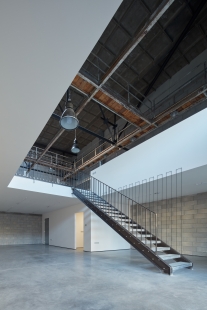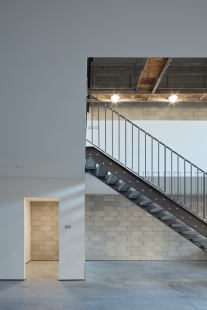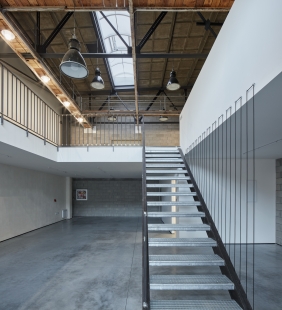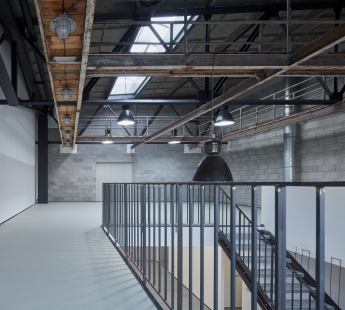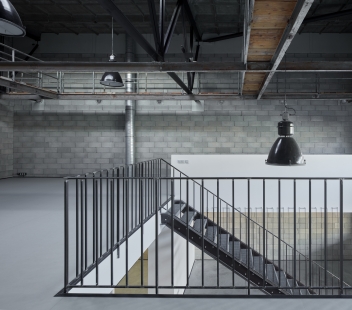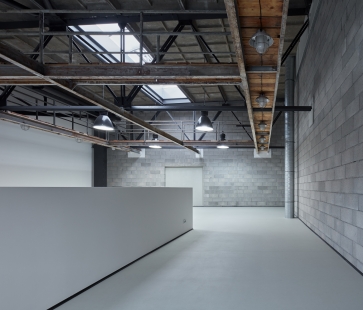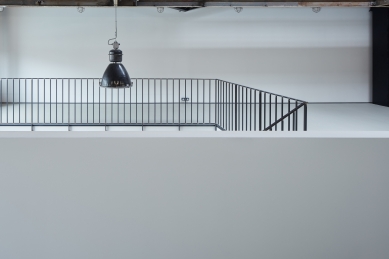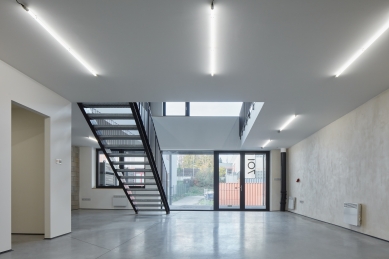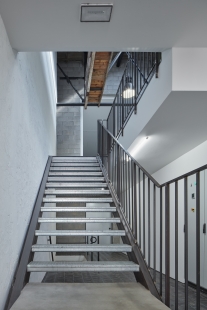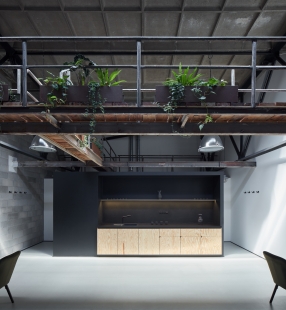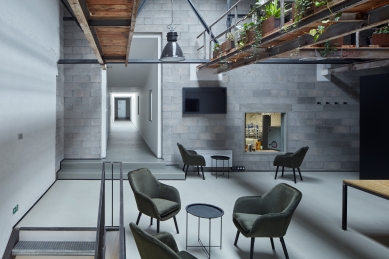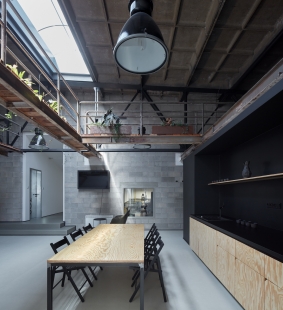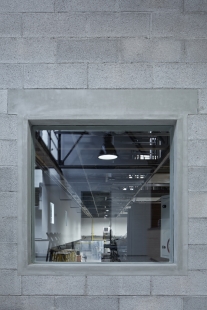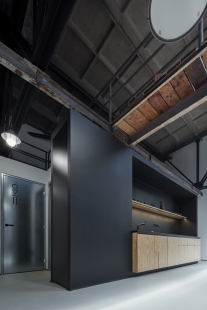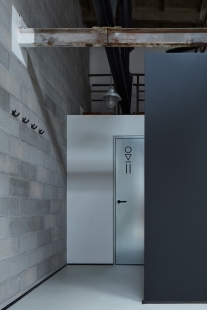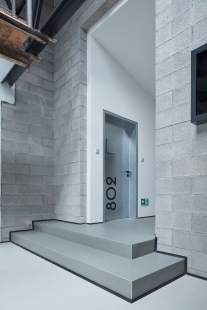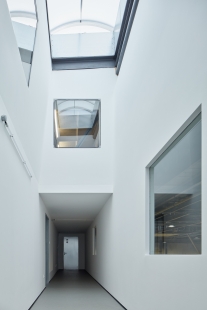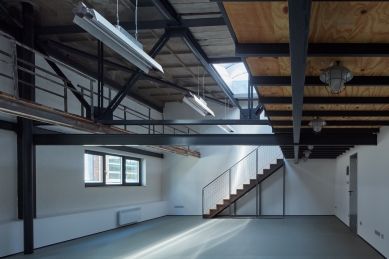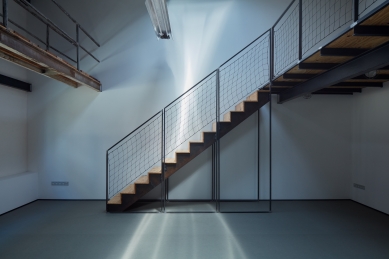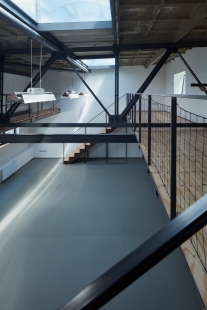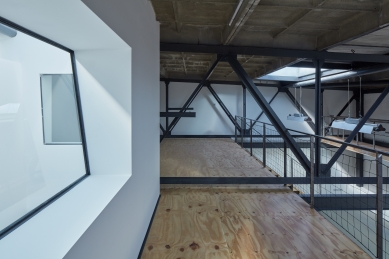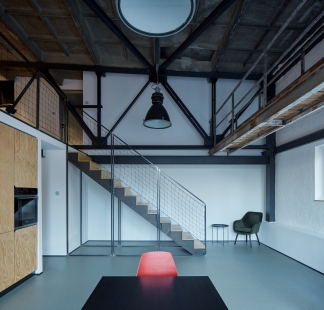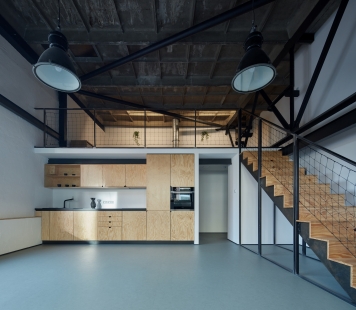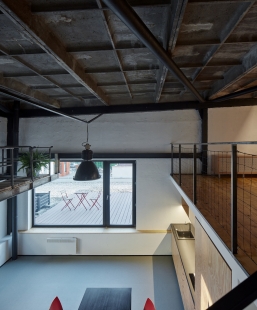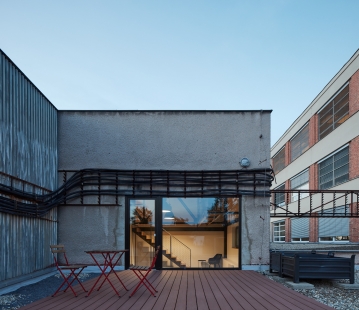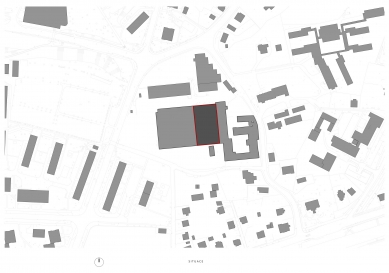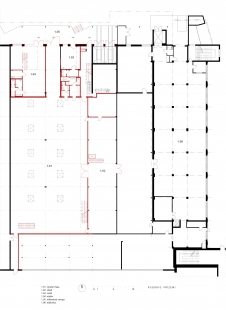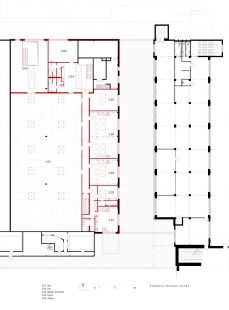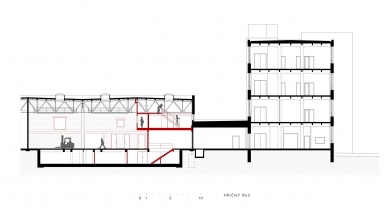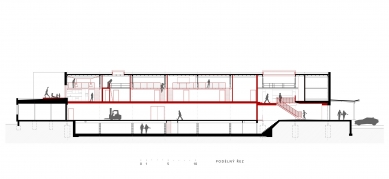
Colorful

Color Factory in Context
The Rožnov mechanical knitting factory was established in 1892 by the Vienna company Brill, Schreiber & Co. Textile production in the later Loana complex was terminated in 2010, and since then, individual buildings have been adapted for new uses. Given the factory's position, there is a partial but significant opening of the area's urbanism to the surrounding town. The new use is already a mix of functions, including light manufacturing, administration, retail, services, and housing.
In one of the buildings, a striking architectural structure from the 1930s in Rožnov, the company STROZA, specializing in the development and manufacture of complex single-purpose machines, has been located since 2011. The investor's philosophy was to create a vibrant building. A part of the building was adapted for its own manufacturing and administrative needs. A whole floor was adapted, according to a design by Henka architects, into a space for creative studios with a DIY gallery and an overlap into cultural activities, known as 3rd Floor.
The need to expand production led the investor to purchase part of the adjacent hall structure of the former dye factory from the 1970s. The continuity of the approach to conversion resulted in a decision not only to expand production and, to an inevitable extent, modify the existing building, but also to take advantage of the offered opportunity to add further functions to the space. Thus enriching and colorizing the life of another part of the complex. Supporting the symbiosis of light industry and the daily work life of the city. This creates another piece in the mosaic, a space called Color Factory. The main starting point, as in the previous realization of the 3rd Floor, is the distinctive form of the building's construction. It forms an industrial aesthetic framework, which, along with the rawness of some parts of the building, is left on display. The effort is to find the right balance between the new and the old. Therefore, the spatial arrangement is subordinated to the structure of the old building. The building does not acquire a completely new face. On the outside, it only slightly adapts with new openings in the facades. The main scene takes place inside. The realization is part of a gradual adaptation, where new layers are created on the old foundation. Perhaps it is less centrally managed, but probably more natural. The whole complex is slowly breaking down into smaller fragments and a new city is emerging.
Color Factory
The façade of the building with a ramp and a steel column structure supporting its roof forms the outdoor entrance space from the street to the new Color Factory with workshops, studios, offices, and an apartment. The main operational area is located on the first floor. From the shared foyer and hallway visually connected to the manufacturing area of the large hall, the individual studios and the apartment at the back are accessible. Additionally, the Color Factory consists of two separately accessible units, large and small. The small single-story one is intended for use as a retail unit or office. The large elevated two-story unit is intended for use as a workshop, office, bistro, etc. The studios and the apartment with a mezzanine are illuminated not only by facade windows but also by soft light from roof skylights. Their mezzanines allow direct contact with the steel structure of truss girders supporting the prefabricated concrete roof panels. The architecture of the interior is built into the existing distinctive structure of the industrial hall, directly utilizing the aesthetic and spatial potential of the roofing. The load-bearing structure serves as a kind of natural decoration of the interior space with its physio-plastic form.
LINKS
Ladislav Baletka, 100 Years of the Knitting Industry in Rožnov pod Radhoštěm 1889-1989, Rožnov pod Radhoštěm 1989
Hana Hlušičková (ed.), Technical Monuments in Bohemia, Moravia, and Silesia III, Prague 2003, pp. 519-520
History and Present of Entrepreneurship in Vsetín, Valašské Meziříčí, and Rožnov, Žehušice, 2007, pp. 76-78, 80
The Rožnov mechanical knitting factory was established in 1892 by the Vienna company Brill, Schreiber & Co. Textile production in the later Loana complex was terminated in 2010, and since then, individual buildings have been adapted for new uses. Given the factory's position, there is a partial but significant opening of the area's urbanism to the surrounding town. The new use is already a mix of functions, including light manufacturing, administration, retail, services, and housing.
In one of the buildings, a striking architectural structure from the 1930s in Rožnov, the company STROZA, specializing in the development and manufacture of complex single-purpose machines, has been located since 2011. The investor's philosophy was to create a vibrant building. A part of the building was adapted for its own manufacturing and administrative needs. A whole floor was adapted, according to a design by Henka architects, into a space for creative studios with a DIY gallery and an overlap into cultural activities, known as 3rd Floor.
The need to expand production led the investor to purchase part of the adjacent hall structure of the former dye factory from the 1970s. The continuity of the approach to conversion resulted in a decision not only to expand production and, to an inevitable extent, modify the existing building, but also to take advantage of the offered opportunity to add further functions to the space. Thus enriching and colorizing the life of another part of the complex. Supporting the symbiosis of light industry and the daily work life of the city. This creates another piece in the mosaic, a space called Color Factory. The main starting point, as in the previous realization of the 3rd Floor, is the distinctive form of the building's construction. It forms an industrial aesthetic framework, which, along with the rawness of some parts of the building, is left on display. The effort is to find the right balance between the new and the old. Therefore, the spatial arrangement is subordinated to the structure of the old building. The building does not acquire a completely new face. On the outside, it only slightly adapts with new openings in the facades. The main scene takes place inside. The realization is part of a gradual adaptation, where new layers are created on the old foundation. Perhaps it is less centrally managed, but probably more natural. The whole complex is slowly breaking down into smaller fragments and a new city is emerging.
Color Factory
The façade of the building with a ramp and a steel column structure supporting its roof forms the outdoor entrance space from the street to the new Color Factory with workshops, studios, offices, and an apartment. The main operational area is located on the first floor. From the shared foyer and hallway visually connected to the manufacturing area of the large hall, the individual studios and the apartment at the back are accessible. Additionally, the Color Factory consists of two separately accessible units, large and small. The small single-story one is intended for use as a retail unit or office. The large elevated two-story unit is intended for use as a workshop, office, bistro, etc. The studios and the apartment with a mezzanine are illuminated not only by facade windows but also by soft light from roof skylights. Their mezzanines allow direct contact with the steel structure of truss girders supporting the prefabricated concrete roof panels. The architecture of the interior is built into the existing distinctive structure of the industrial hall, directly utilizing the aesthetic and spatial potential of the roofing. The load-bearing structure serves as a kind of natural decoration of the interior space with its physio-plastic form.
LINKS
Ladislav Baletka, 100 Years of the Knitting Industry in Rožnov pod Radhoštěm 1889-1989, Rožnov pod Radhoštěm 1989
Hana Hlušičková (ed.), Technical Monuments in Bohemia, Moravia, and Silesia III, Prague 2003, pp. 519-520
History and Present of Entrepreneurship in Vsetín, Valašské Meziříčí, and Rožnov, Žehušice, 2007, pp. 76-78, 80
The English translation is powered by AI tool. Switch to Czech to view the original text source.
0 comments
add comment


